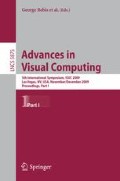Abstract
This paper revisits the pose estimation from point correspondences problem to properly exploit data provided by a GPS. In practice, the location given by the GPS is only a noisy estimate, and some point correspondences may be erroneous. Our method therefore starts from the GPS location estimate to progressively refine the full pose estimate by hypothesizing correct correspondences. We show how the GPS location estimate and the choice of a first random correspondence dramatically reduce the possibility for a second correspondence, which in turn constrains even more the remaining possible correspondences. This results in an efficient sampling of the solution space. Experimental results on a large 3D scene show that our method outperforms standard approaches and a recent related method [1] in terms of accuracy and robustness.
Access this chapter
Tax calculation will be finalised at checkout
Purchases are for personal use only
Preview
Unable to display preview. Download preview PDF.
References
Moreno-Noguer, F., Lepetit, V., Fua, P.: Pose priors for simultaneously solving alignment and correspondence. In: Forsyth, D., Torr, P., Zisserman, A. (eds.) ECCV 2008, Part II. LNCS, vol. 5303, pp. 405–418. Springer, Heidelberg (2008)
Takacs, G., Chandrasekhar, V., Gelfand, N., Xiong, Y., Chen, W.C., Bismpigiannis, T., Grzeszczuk, R., Pulli, K., Girod, B.: Outdoors augmented reality on mobile phone using loxel-based visual feature organization. In: ACM international conference on Multimedia information retrieval, pp. 427–434. ACM, New York (2008)
Klein, G., Drummond, T.: Tightly integrated sensor fusion for robust visual tracking. Image and Vision Computing 22 (2004)
Carceroni, R., Kumar, A., Daniilidis, K.: Structure from motion with known camera positions. In: CVPR, pp. 477–484 (2006)
You, S., Neumann, U.: Fusion of vision and gyro tracking for robust augmented reality registration. In: IEEE Conference on Virtual Reality, pp. 71–78 (2001)
Ng, T.K., Kanade, T.: PALM: portable sensor-augmented vision system for large-scene modeling. In: 3-D Digital Imaging and Modeling, pp. 473–482 (1999)
Pollefeys, M., Nistèr, D., Frahm, J.M., Akbarzadeh, A., Mordohai, P., Clipp, B., Engels, C., Gallup, D., Kim, S.J., Merrell, P., Sinha, S., Talton, B., Wang, L., Yang, Q., Stewènius, H., Yang, R., Weclh, G., Towles, H.: Detailed real-time urban 3d reconstruction from video. International Journal of Computer Vision (2007)
Nister, D.: Preemptive RANSAC for live structure and motion estimation. In: ICCV, vol. 1, pp. 199–206 (2003)
Chum, O., Matas, J.: Randomized RANSAC with Td,d test. In: BMVC, pp. 448–457 (2002)
Tordoff, B., Murray, D.W.: Guided sampling and consensus for motion estimation. In: Heyden, A., Sparr, G., Nielsen, M., Johansen, P. (eds.) ECCV 2002. LNCS, vol. 2350, pp. 82–96. Springer, Heidelberg (2002)
Guo, F., Aggarwal, G., Shafique, K., Cao, X., Rasheed, Z., Haering, N.: An efficient data driven algorithm for multi-sensor alignment. In: Workshop on Multi-camera and Multi-modal Sensor Fusion Algorithms and Applications, ECCV (2008)
Chum, O., Matas, J.: Matching with PROSAC - progressive sample consensus. In: CVPR, pp. 220–226 (2005)
Pylvänäinen, T., Fan, L.: Hill climbing method for random sample consensus methods. In: International Symposium on Visual Computing (2007)
Chum, O., Matas, J., Kittler, J.: Locally optimized RANSAC. In: Porceedings of the 25th DAGM Symposium Pattern Recognition, pp. 236–243 (2003)
Myatt, D., Bishop, J., Craddock, R., Nasuto, S., Torr, P.H.: NAPSAC: High noise, high dimensional robust estimation — it’s in the bag. In: BMVC, pp. 458–467 (2002)
Tordoff, B.J., Murray, D.W.: Guided-MLESAC: Faster image transform estimation by using matching priors. IEEE Transactions on Pattern Analysis and Machine Intelligence 27, 1523–1535 (2005)
Raguram, R., Frahm, J.M., Pollefeys, M.: A comparative analysis of ransac techniques leading to adaptive real-time random sample consensus. In: Forsyth, D., Torr, P., Zisserman, A. (eds.) ECCV 2008, Part II. LNCS, vol. 5303, pp. 500–513. Springer, Heidelberg (2008)
Torr, P.H., Zisserman, A.: MLESAC: A new robust estimator with application to estimating image geometry. Computer Vision and Image Understanding 78, 138–156 (2000)
Torr, P.H., Davidson, C.: IMPSAC: Synthesis of importance sampling and random sample consensus. IEEE Transactions on Pattern Analysis and Machine Intelligence 25, 354–364 (2003)
Bay, H., Ess, A., Tuytelaars, T., Van Gool, L.: SURF: Speeded up robust features. In: Computer Vision and Image Understanding (2008)
Louarkis, M., Argyros, A.: The design and implementation of a generic sparse bundle adjustment software package based on the Levenberg-Marquardt algorithm. Technical Report 340, Computer Science-FORTH, Heraklion, Crete, Greece (2004)
Author information
Authors and Affiliations
Editor information
Editors and Affiliations
Rights and permissions
Copyright information
© 2009 Springer-Verlag Berlin Heidelberg
About this paper
Cite this paper
Pylvänäinen, T., Fan, L., Lepetit, V. (2009). Revisiting the PnP Problem with a GPS. In: Bebis, G., et al. Advances in Visual Computing. ISVC 2009. Lecture Notes in Computer Science, vol 5875. Springer, Berlin, Heidelberg. https://doi.org/10.1007/978-3-642-10331-5_76
Download citation
DOI: https://doi.org/10.1007/978-3-642-10331-5_76
Publisher Name: Springer, Berlin, Heidelberg
Print ISBN: 978-3-642-10330-8
Online ISBN: 978-3-642-10331-5
eBook Packages: Computer ScienceComputer Science (R0)

